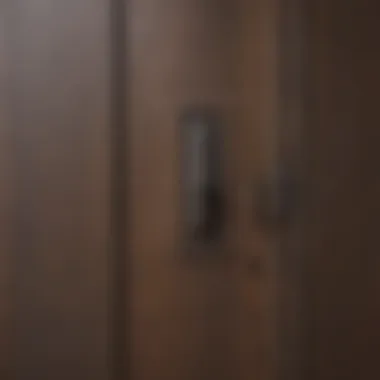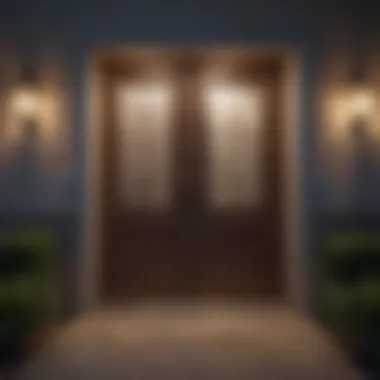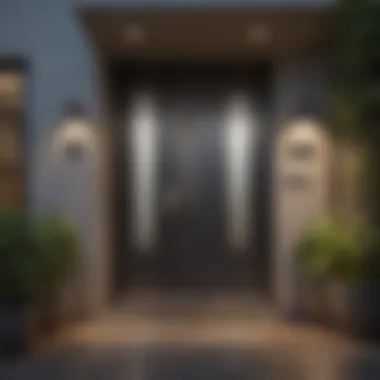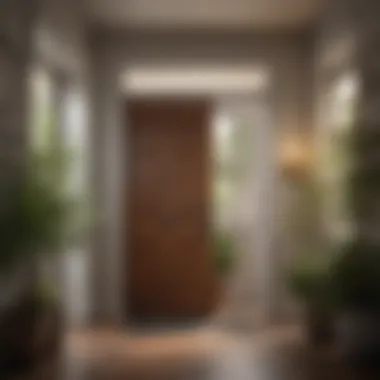Understanding the Cost of Front Door Installation


Intro
When considering a front door installation, one must delve into various elements that shape the overall cost. This involves more than just the price tag on the door itself; it brings into play variables like materials, labor, and additional features that enhance functionality and aesthetics. Installing a front door is not just an aesthetic enhancement to your home; it is also a crucial upgrade that can affect energy efficiency, security, and first impressions.
In this article, we will explore each aspect that contributes to the costs associated with front door installation. Understanding these factors allows homeowners and renters alike to assess their budgeting needs and ultimately make informed choices.
Design Inspirations
Trending Styles
The design of your front door can dramatically shift the overall appearance of your property. Currently, popular styles range from the classic traditional wooden doors to the modern minimalist designs often featuring glass panels or sleek metal accents. Homeowners may also consider transitional styles that merge the old with the new, creating a unique charm that suits personal tastes while aligning with modern trends.
Color Palettes
Color is crucial in making a statement with your front door. Bold colors like deep blue or vibrant red can be striking, while neutral shades like taupe or white offer a timeless appeal. Selecting a color that complements the surrounding architecture not only enhances the door's appearance but also supports the overall aesthetic harmony of the home.
Factors Influencing Cost
The cost breakdown for front door installation includes several critical elements. Below are key factors to consider:
- Materials: Options range from the affordability of fiberglass to the luxury of solid wood.
- Labor: Installation costs can vary depending on the complexity of the job and local labor rates.
- Additional Features: Features like high-security locks, weatherproofing, and smart technology can impact the total cost.
- Geographic Variations: Local market conditions and building regulations play a significant role in costs.
"Understanding the intricate details governing your door's installation is essential for making educated decisions that align with your financial plans."
With a grasp on design inspirations and the cost factors, one can approach front door installation with a clearer picture. This enables better decision-making that reflects both personal taste and practicality.
Prelims to Front Door Installation Costs
Understanding the costs associated with front door installation is essential for homeowners considering an upgrade to their home's entryway. This section explores the significance of knowing these costs, as it allows for well-informed decisions that can affect both aesthetics and functionality of a home.
When contemplating the installation of a new front door, several elements come into play. The choice of material, size, design, and installation methods not only impact the overall style of the house but also contribute heavily to the financial outlay involved. One must consider that an entryway serves as both a welcome and a security measure. Therefore, investing in a quality front door can enhance curb appeal while providing essential safety features.
It's also worth noting that understanding costs can help in budget allocation. Many homeowners are surprised by how various factors can escalate the price unexpectedly. For instance, opting for custom sizes or premium materials can significantly increase installation expenses. Knowing these factors empowers homeowners to prioritize their needs effectively.
Furthermore, the labor aspect of door installation is not to be overlooked. It can vary widely depending on the complexity of the installation and the locale in which the project is taking place. Recognizing the potential labor costs can lead to strategic planning, whether that involves hiring a professional or undertaking a DIY project.
In summary, familiarity with the components influencing the costs of front door installation is beneficial. It guides homeowners in making choices that align with their financial capabilities while ensuring their home's entryway is both attractive and functional.
Factors Influencing Cost
Understanding the factors influencing the cost of front door installation is crucial for homeowners and renters alike. The overall cost is shaped by several specific elements, including the type of material chosen, the dimensions of the door, and the complexity of the design. Each of these components impacts not just the price but also the longevity, aesthetic appeal, and functional effectiveness of the door. Knowing these factors allows individuals to make more informed choices that align with their budget and style preferences.
Material Types
Materials directly affect both the cost and the performance of doors. Choices in material can dictate aspects such as durability, maintenance, and energy efficiency.
Wood
Wood is a traditional material often selected for its natural beauty and versatility. Its key characteristic is its ability to be customized easily. Homeowners can opt for various finishes and styles, allowing for integration with existing home decor. One unique feature of wood is its excellent insulation properties. However, wood requires regular upkeep to prevent warping or insect damage. Although wood doors can be more expensive, their aesthetic appeal often justifies the investment.
Fiberglass
Fiberglass doors are gaining popularity due to their beneficial aspects such as low maintenance and high energy efficiency. The material is resistant to dents and scratches, making it a practical choice. A unique feature of fiberglass is its ability to mimic wood's appearance while providing superior durability. The downside, however, is that high-quality fiberglass doors can be pricey compared to wood. Still, their long-term benefits may outweigh the initial costs.
Steel


Steel doors are known for their key characteristic of security and durability. They are a popular choice for those looking to enhance home protection. A unique feature of steel is its potential for energy efficiency through insulation. While typically less expensive than wood or fiberglass, they may dent and need repainting over time. Nonetheless, for security-conscious homeowners, the advantages of steel doors can be compelling.
Composite
Composite doors combine various materials, offering strength and durability. The key characteristic is that they resist warping and typically need less maintenance. A unique feature of composites is their ability to mimic the appearance of wood while often being lighter. Their cost can vary significantly depending on the manufacturer and specific features. Thus, they represent a versatile and practical option for many.
Size and Dimensions
Size and dimensions significantly influence installation costs. Customization is often necessary for achieving the right fit in existing frames.
Standard Sizes
Standard sizes are popular for several reasons, including convenience and cost-effectiveness. They tend to be more readily available, which lowers both the price and the time for delivery and installation. A unique feature is their compatibility with various entryways. Homeowners can benefit from the lower prices associated with these sizes, but they may not suit all homes perfectly.
Custom Sizes
Custom sizes allow homeowners to cater specifically to their entryway needs. While this option provides the advantage of a tailored fit, it comes at a higher price. The key characteristic is the flexibility in design choices. This means homeowners can achieve unique looks that standard sizes may not provide. However, the longer lead time and higher expenses are significant considerations against this option.
Design Complexity
The complexity of the design plays a critical role in the overall cost of door installation. Factors like panel styles and glass inclusions can affect both materials and labor costs.
Panel Styles
Panel styles are a key consideration when determining the cost of a door. More intricate designs may significantly increase the cost due to the additional materials and labor involved. A unique feature of diverse panel styles is their strong influence on the door's visual impact. While simpler designs cost less, elaborate options can enhance curb appeal but often come at a premium.
Inclusions of Glass
Inclusions of glass in door design serve practical and aesthetic purposes. They can enhance natural light and visibility, but they also typically increase costs. The key characteristic here is the balance between beauty and functionality. A unique aspect is the potential for energy-efficient glass options, which can offset some costs through saved energy expenses. However, glass inclusions can be more fragile, requiring careful consideration of long-term maintenance.
Understanding these factors helps in making well-informed decisions that suit your home needs and budget.
Labor Costs
Understanding the labor costs involved in front door installation is critical for homeowners planning their projects. Labor costs can vary widely based on multiple factors, including location, the complexity of the installation, and the experience of the contractor. A thorough grasp of these costs helps in budgeting accurately and avoiding any surprises that could occur during the installation process.
Hourly Rates
Hourly rates for labor typically fluctuate based on geographical areas. Urban environments generally see higher hourly rates, given the increased cost of living and demand for skilled labor. In contrast, rural locations may have lower hourly charges.
- Skilled Labor: Professionals with extensive experience in door installation may command higher rates, reflecting their expertise.
- Average Range: Rates can often range from $25 to $75 per hour, depending on the factors mentioned.
- Features of Service: Some workers might include services such as removing the old door or providing clean-up, which can affect hourly rates.
It is advisable to obtain several quotes to ensure you understand the market rate. This can help homeowners to make informed decisions about the labor aspect of their costs.
Flat Fees for Installation
Some contractors offer flat fees for front door installation. This pricing mode can be beneficial for budget-conscious homeowners because it provides a clear estimate from the beginning. Flat fees often cover the complete installation process, which may include:
- Inspection of the Site: Assessing the space and ensuring readiness for the new door.
- Installing New Hardware: This may encompass locks and hinges, depending on the chosen door.
- Ensuring Proper Fit: Confirming alignment and functionality post-installation.
Flat fees typically range from $150 to $1,500 or more, influenced by the complexity of the project and the type of door selected. Homeowners should clarify what the flat fee encompasses to ensure no hidden costs arise later in the project.
It is crucial to confirm whether flat fees cover all labor and material costs or if any additional charges will apply during installation.
By paying close attention to labor costs, homeowners can ensure their budgeting is strategic. A clear understanding of the labor market not only aids in determining an appropriate budget but also helps in selecting the right contractor for your front door project.


Additional Costs to Consider
When planning for front door installation, it is crucial to consider additional costs that often come with the process. These expenses can significantly impact your overall budget and should not be overlooked. Understanding these factors helps in creating a more accurate financial plan, ensuring you are fully prepared for the entire project.
Removal of Existing Door
Removing an existing door may seem like a minor detail, but it can add considerable costs. The labor involved in taking out the old door and frames can vary based on its condition and the installation complexity. Usually, an old door might be attached with screws or nails that can make the removal tricky, especially if there is rotting wood or damage present.
Homeowners should expect to pay extra for this service when hiring professionals. This step is necessary to ensure the new door fits correctly and functions properly. In some cases, additional repairs might be needed to the surrounding area where the old door was removed, further contributing to costs.
Hardware and Accessories
Hardware and accessories are essential components of front door installations that can add to the overall cost. The selection of hardware not only affects the aesthetics of the door but also plays a significant role in its function and security. Here, we will look closely at three important accessories: locks, hinges, and handles.
Locks
Locks are critical for the security of your home. They come in various types, including deadbolts, smart locks, and keyless entry systems. A high-quality lock improves home security and can deter potential intruders. The main characteristic of good locks is durability. For example, a grade 1 deadbolt provides the highest level of residential security, making it a popular choice.
However, smart locks can offer additional features like remote access and tracking, which may be a beneficial addition. While they may have a higher upfront cost, their convenience might outweigh the expense.
Hinges
Hinges support the door and allow it to swing open and close smoothly. Several types of hinges exist, such as butt hinges, continuous hinges, and pivot hinges. One key characteristic of sturdy hinges is their load-bearing capacity. Good hinges can enhance door longevity and performance, a significant aspect for smooth operation.
Choosing high-quality hinges might increase costs, but their durability ensures fewer replacements in the long run. Conversely, inexpensive hinges might wear faster and lead to additional repair costs.
Handles
Handles, though often overlooked, directly influence the first impression of your entryway. They come in various designs and materials, such as brass, stainless steel, or even glass. A key characteristic is ease of use, as a well-designed handle makes entering and exiting convenient.
High-quality handles can be a bit more pricey, but they offer an aesthetic appeal and durability. On the other hand, cheaper options may not last as long or provide the same style, causing potential replacements sooner than expected.
Overall, understanding these additional costs allows homeowners to better prepare and make informed decisions when installing a front door.
By factoring in the removal of existing doors, as well as the hardware and accessories needed, you can create a more precise budget before beginning your project.
Average Price Ranges
Understanding the average price ranges for front door installation is critical for homeowners. Knowing what to expect can prevent unexpected financial strain and aid in better planning. It provides a benchmark for evaluating quotes from contractors and guiding your funding approach. This section outlines the predominant price categories, offering clarity on what one might anticipate in various scenarios.
Low-End Installations
Low-end installations typically involve simpler materials and basic designs. These installations can cost between $300 and $800, including both the door and installation service. Generally, the doors used in this category are made from materials like hollow core wood or basic fiberglass. The emphasis here is on function rather than aesthetics. Basic locks and hinges often accompany these doors. It is imperative to remeber that while the upfront costs may be low, the longevity and durability might be compromised, leading to potential replacement sooner than anticipated.
Mid-Range Installations
Mid-range installations reflect a balance between quality and affordability. Prices usually range from $800 to $2,000. Doors in this category might include solid wood or higher-quality fiberglass and steel options. These installations often offer custom sizes and designs that still do not reach premium pricing. Improved hardware such as advanced locking systems and stylish handles is common in this group. Homeowners can expect these doors to last longer and to provide additional security that may align with a slightly higher expenditure.
High-End Installations
High-end installations represent the pinnacle of the market, with costs generally starting at $2,000 and exceeding $5,000. These installations often include custom designs, premium materials, and additional features like glass panels. Many high-end doors are made of exotic woods or top-tier fiberglass composites. The installation in this category may also involve significant custom work to ensure precise fitting and optimal aesthetics. Best quality locks and hinges are a standard requirement, emphasizing both durability and security. Homeowners choosing high-end doors typically prioritize design and functionality, investing in upgrades that boost curb appeal and energy efficiency.
"Investing in the right front door installation can greatly increase the value and security of your home."
Regional Price Variations


Understanding regional price variations is crucial when it comes to front door installation costs. Different regions exhibit distinct economic conditions, which influence labor costs, material availability, and overall pricing strategies within the market. Recognizing these variations can help homeowners better plan their budgets and expectations.
Urban vs. Rural Costs
Urban areas typically have higher installation costs compared to rural locations. This difference arises from several factors. First, real estate prices tend to be elevated in cities, leading to increased demand for construction work and higher wages for contractors. Additionally, urban regions often face higher costs for materials due to transportation fees and the availability of specialty products. Therefore, homeowners living in cities should anticipate significant price differences when installing a front door opposed to those in the countryside.
In rural areas, labor and material costs might be lower. However, there is a potential drawback: the limited availability of specialized contractors or premium materials. Homeowners should also be aware that the time needed for installation in remote locations may be longer due to fewer available resources.
Impact of Local Labor Markets
The local labor market plays a vital role in determining front door installation costs. In regions with a robust economy and high employment rates, labor costs may surge due to increased competition. Contractors in these areas can charge more for their services, knowing that demand is high. In contrast, regions with higher unemployment may see lower labor costs as contractors compete for jobs. In such cases, homeowners might find opportunities for significant savings.
"A slight variation in labor costs can lead to substantial differences in overall project pricing based on geographical location."
Moreover, local labor markets may reflect different skill levels. Some areas may lack experienced installers, resulting in increased prices for specialized work. It's imperative for homeowners to research local labor rates and availability before commencing their installation project.
DIY vs. Professional Installation
Deciding between DIY installation and hiring professionals is a crucial element in front door installation costs. Homeowners must weigh the benefits and potential drawbacks of each option. This section sheds light on important considerations, helping readers make an informed choice.
Benefits of DIY
Opting for a DIY installation can be appealing for several reasons. First, it usually leads to cost savings. Homeowners avoid labor fees, which can take up a significant portion of the total installation cost. By executing the task themselves, skilled individuals can allocate funds elsewhere, perhaps to higher-quality materials.
Additionally, DIY projects allow for a personal touch in design and execution. Homeowners can customize the installation to meet their particular aesthetic preferences. The sense of accomplishment after completing such a project also contributes positively to one’s home ownership experience.
However, one must also factor in time. DIY installation can be time-consuming, and if mistakes occur, they often result in additional costs to correct, negating initial savings. Therefore, careful evaluation of one’s own skills and time availability is essential before committing to this path.
Benefits of Hiring Professionals
On the other hand, selecting professional installation offers distinct advantages. Expertise in installation ensures a smooth process. Professionals have the required experience and knowledge to handle unexpected challenges. Squarely focusing on complexities like structural integrity or potential building codes can save future headaches for homeowners.
Furthermore, hiring experts often comes with warranties or guarantees on their work. This assurance can provide peace of mind, especially in terms of long-term performance and security of the installed door.
"Engaging a professional installer can often prevent costly mistakes that may arise from a DIY approach, ensuring that the installation meets industry standards."
While there is a higher upfront cost to consider, the potential long-term durability and superior results may justify the expense. Homeowners weighing these options should assess their comfort level with home improvement tasks and the specific needs of their installation project.
Budgeting for Your Project
Budgeting for your front door installation is a critical step that can determine the outcome of your project. Understanding how much you are willing and able to spend will guide you through the selection process, where you can prioritize features and materials that resonate with your vision.
Setting a budget has specific benefits. It helps in managing expectations and prevents unexpected financial stress during the installation process. If you have a realistic budget, you can avoid overspending, allowing for other home improvements or necessary renovations that may arise later. Additionally, it provides a framework for making choices around materials and labor, ensuring that decisions align with your financial capacity.
Key considerations when budgeting include:
- Material Costs: Different materials carry different price points. Wood, fiberglass, steel, and composite vary significantly in expense.
- Labor Rates: Installation costs can fluctuate based on geographical areas and the complexity of the installation.
- Add-On Features: Any specialized features, such as custom designs or smart locks, can elevate costs. Be mindful of such inclusions as they may stretch your budget if not planned well.
By considering these elements, you empower yourself with knowledge to make informed decisions throughout the installation process.
Finale
This article has explored the multifaceted aspects of front door installation costs. Understanding these costs is critical for homeowners and renters alike. A front door does not just provide security; it also enhances the aesthetic appeal of a home. Consequently, knowing the financial implications is paramount for making informed decisions.
Several key elements stand out. Firstly, the material of the door can greatly vary the overall price. Material types like wood, fiberglass, and steel each have their benefits and price points. The size and complexity of design also contribute to the final costs, which can be significant, especially if opting for custom solutions.
Labor costs, whether hourly rates or flat fees, must not be neglected. Professional installation may seem like an elevated expense, yet it often ensures quality and longevity, which can save money in the long run. Furthermore, additional costs—such as removing an old door or the necessary hardware—are vital considerations that can affect the budget unexpectedly.
By clearly outlining average price ranges, from low-end to high-end installations, this article empowers buyers to set realistic budgets. Regional price variations can also adjust expectations; homeowners in urban areas might have different costs compared to those in rural settings, a fact that should not be overlooked when planning.
Budgeting techniques discussed here, such as identifying potential savings, provide guidance that can mitigate overspending. Choosing appropriately between DIY efforts or hiring professionals ultimately depends on skill level and comfort with installation tasks.
In summary, this article serves as a comprehensive resource that highlights the numerous factors affecting front door installation costs. With this knowledge, homeowners can navigate the complexities of this enhancement with confidence, ensuring their entryways not only meet functional needs but also reflect personal style.







